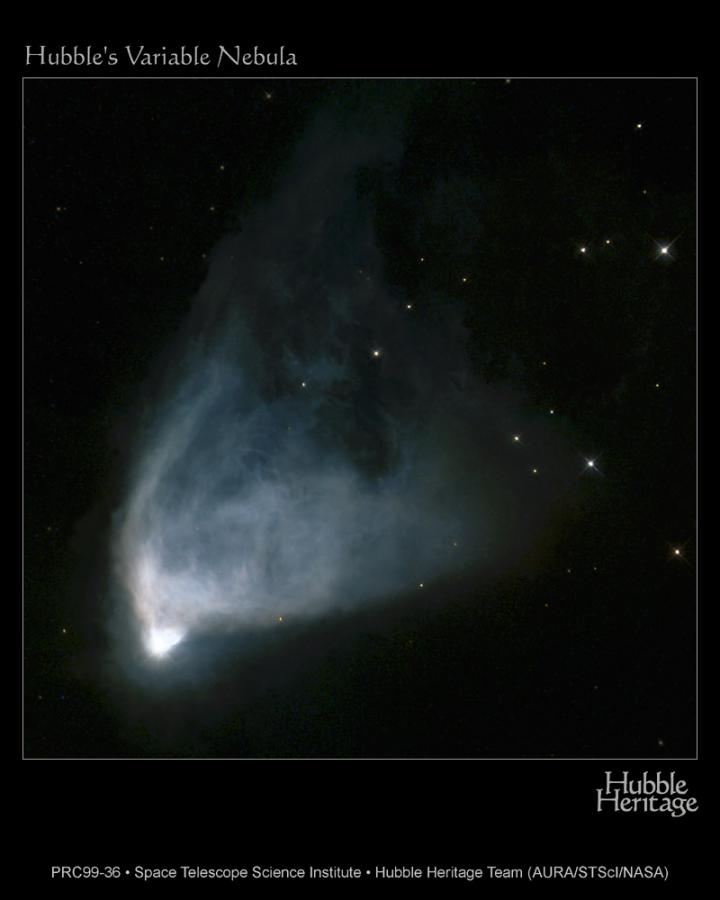Photonic booms may help illuminate astronomical secrets

This image depicts Hubble's Variable Nebula. Credit: William Sparks (STScI), Sylvia Baggett (STScI) et al., & the Hubble Heritage Team (AURA/ STScI/ NASA)
At a meeting of the American Astronomical Society in Seattle, Wash., today, Robert Nemiroff, a physics professor at Michigan Technological University, reported that this theoretical curiosity may turn out to be practically useful out in the cosmos. When a superluminal sweep occurs, it typically starts with a flash that may reveal previously unknown three-dimensional information about the scattering object.
Flashes, dubbed “photonic booms” because they are directly analogous to sonic booms, may be detectable on the Moon, on passing asteroids, on fast moving shadows cast on reflecting dust clouds near variable stars, and on objects illuminated by the rapidly rotating beam of a pulsar, said Nemiroff, author of a study accepted for publication by the Publications of the Astronomical Society of Australia, with a preliminary version available online at http://arxiv.
“The concept, although not proven in practice, is quite intriguing,” said Rosanne Di Stefano, a leading researcher at the Harvard-Smithsonian Center for Astrophysics.
To reveal the size and surface features of asteroids passing near the Earth, a laser beam might be swept across the rock's surface thousands of times a second, with each sweep forcing a harmless but telling photonic boom. The flashes could be recorded with high-speed cameras attached to large telescopes, potentially mapping out major features on the asteroid.
Photonic booms could also be seen much farther out in the universe. An example occurs in Hubble's Variable Nebula in the constellation of Monoceros. There, shadows cast by clouds moving between the bright star “R Mon” and reflecting dust move so fast that they might create photonics booms visible even for days or weeks.
The physics that creates the photonic boom is tied to the faster-than-light sweep speeds of the illuminating spots and cast shadows. Specifically, a flash is seen by an observer when the speed of the scattered spot toward the observer drops from above the speed of light to below the speed of light. The phenomenon is possible only because the spots contain no mass and so cannot only move faster than light, but decelerate past the speed of light without violating Einstein's theory of special relativity.
Details of the effect hinge on the interplay between the time it takes for a sweeping light beam to cross an object, and the time it takes for the light beam to traverse the depth of the object. Therefore, measuring photonic booms gives information about the depth of the scatterer. Were the Moon just a flat disk on the sky, for example, no photonics boom would occur.
“Photonic booms happen around us quite frequently — but they are always too brief to notice,” says Nemiroff. “Out in the cosmos they last long enough to notice — but nobody has thought to look for them!”
The light flash from a photonic boom is quite different from well-known Cherenkov radiation, light emitted when a charged object breaks the speed of light inside transparent matter, he notes.
Michigan Technological University is a leading public research university developing new technologies and preparing students to create the future for a prosperous and sustainable world. Michigan Tech offers more than 130 undergraduate and graduate degree programs in engineering; forest resources; computing; technology; business; economics; natural, physical and environmental sciences; arts; humanities; and social sciences.
Media Contact
All latest news from the category: Physics and Astronomy
This area deals with the fundamental laws and building blocks of nature and how they interact, the properties and the behavior of matter, and research into space and time and their structures.
innovations-report provides in-depth reports and articles on subjects such as astrophysics, laser technologies, nuclear, quantum, particle and solid-state physics, nanotechnologies, planetary research and findings (Mars, Venus) and developments related to the Hubble Telescope.
Newest articles

Skyrmions move at record speeds
… a step towards the computing of the future. An international research team led by scientists from the CNRS1 has discovered that the magnetic nanobubbles2 known as skyrmions can be…

A flexible and efficient DC power converter for sustainable-energy microgrids
A new DC-DC power converter is superior to previous designs and paves the way for more efficient, reliable and sustainable energy storage and conversion solutions. The Kobe University development can…

Technical Trials for Easing the (Cosmological) Tension
A new study sorts through models attempting to solve one of the major challenges of contemporary cosmic science, the measurement of its expansion. Thanks to the dizzying growth of cosmic…





















